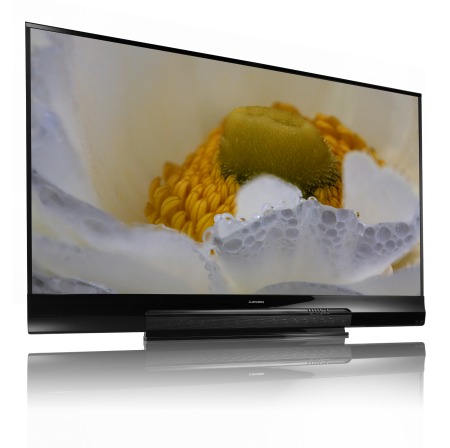Mitsubishi is known for its large screen TVs, with current models ranging from 60 to 82 inches in screen size. Soon a new giant will be added to the line-up. This week at the Consumer Electronics Show Mitsubishi unveiled its massive 92-inch model (WD-92840), which joins the company's line of 3D Home Cinema TVs. As with the other 3D TVs it is driven by the same core DLP technology used by many 3D movie theaters.
Announced features for the set include a built-in 3D emitter, StreamTV Internet Media, Multi-speaker Immersive Sound Technology (IST), Center Channel Mode w/Center Channel input, Rear Channel Pre-outputs, Sub-woofer Output, Bluetooth Streaming Audio, 4 HDMI input, ISFccc, USB Media player, Advanced Calibration Mode, Universal Remote Control, 120Hz Sub-Frame Rate, Jade User Interface and New Clear Contrast Screen.
"3D TV has formally arrived, and unit sales in 2010 certainly underscore this fact. 3D dominated box office numbers, as consumers flocked to the cinema to lose themselves in the fully immersive experience that large screen 3D delivers," says Max Wasinger, executive vice president, sales and marketing, Mitsubishi Digital Electronics America. "Our focus at Mitsubishi is to replicate the cinematic 3D experience in the home, and our broad offering of very large screen 3D Home Cinema and 3D LaserVue TVs do just that."
Pricing and availability for the newly unveiled set is yet to be announced. The company further offered up a large selection of large-screen TV sets, including its 3D equipped LaserVue panels. The sets are currently available in 60-, 65-, 73- and 82-inch sizes.

Mitsubishi also proved once again this year that hearing is believing, and the attendees of the Consumer Electronics Show were treated to the sound of Mitsubishi's Unisen Immersive Sound HDTVs. The models features 16 intelligent speakers that direct balanced audio waves beside and behind the user to reproduce 5.1 surround sound from the panel. These sets utilize an advanced algorithm that delays the sound beams and thus protects them independently from the 16 speakers at varying intervals to create the simulated surround sound field.
Where to Buy: